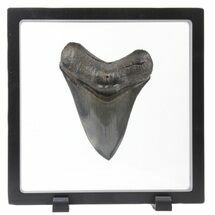This Specimen has been sold.
1.65" Fossil Cycadophyte Seed Cone - Boujdour, Morocco
This is a 1.65" Eocene-aged fossil seed cone or fruit of some kind, found in the Sahara Desert west of Boujdour, Morocco.
About Fossil Seed Cones From The Western Sahara
These seed cones found in the Western Sahara of Morocco have are a bit of a mystery and have not yet been described. They are often labeled is "pine cones" and there has also been speculation that they might be aggregate fruits or horsetail seed pods. But, most likely these silica-replaced (agatized) fossils are the seed pods of Cycadophytes. These fossil cones often bear the signs of insect predation, being partially eaten.
What Is A Cycadophyte?
A cycadophyte is a member of the Cycadophyta, a group of ancient seed-producing plants that includes both modern cycads and their long-extinct relatives. These plants are gymnosperms, meaning their seeds are not enclosed within a fruit, distinguishing them from flowering plants. Cycadophytes typically have a palm-like appearance, with stout, woody trunks topped by a crown of large, stiff, evergreen leaves. Despite their superficial resemblance to palms or ferns, they are not closely related to either group.
Cycadophytes are dioecious, with individual plants producing either male or female reproductive structures in the form of cones. They are known for their slow growth and remarkable longevity, with some individuals living for several centuries. This group first appeared during the Permian Period, more than 250 million years ago, and reached its peak abundance during the Mesozoic Era—a time often referred to as the "Age of Cycads" due to their widespread dominance in prehistoric ecosystems.
These seed cones found in the Western Sahara of Morocco have are a bit of a mystery and have not yet been described. They are often labeled is "pine cones" and there has also been speculation that they might be aggregate fruits or horsetail seed pods. But, most likely these silica-replaced (agatized) fossils are the seed pods of Cycadophytes. These fossil cones often bear the signs of insect predation, being partially eaten.
What Is A Cycadophyte?
A cycadophyte is a member of the Cycadophyta, a group of ancient seed-producing plants that includes both modern cycads and their long-extinct relatives. These plants are gymnosperms, meaning their seeds are not enclosed within a fruit, distinguishing them from flowering plants. Cycadophytes typically have a palm-like appearance, with stout, woody trunks topped by a crown of large, stiff, evergreen leaves. Despite their superficial resemblance to palms or ferns, they are not closely related to either group.
Cycadophytes are dioecious, with individual plants producing either male or female reproductive structures in the form of cones. They are known for their slow growth and remarkable longevity, with some individuals living for several centuries. This group first appeared during the Permian Period, more than 250 million years ago, and reached its peak abundance during the Mesozoic Era—a time often referred to as the "Age of Cycads" due to their widespread dominance in prehistoric ecosystems.
SPECIES
Cycadophyte sp.
AGE
LOCATION
West of Boujdour, Sahara Desert, Morocco
SIZE
1.65" long
CATEGORY
SUB CATEGORY
ITEM
#288785
We guarantee the authenticity of all of our specimens.
 Reviews
Reviews












